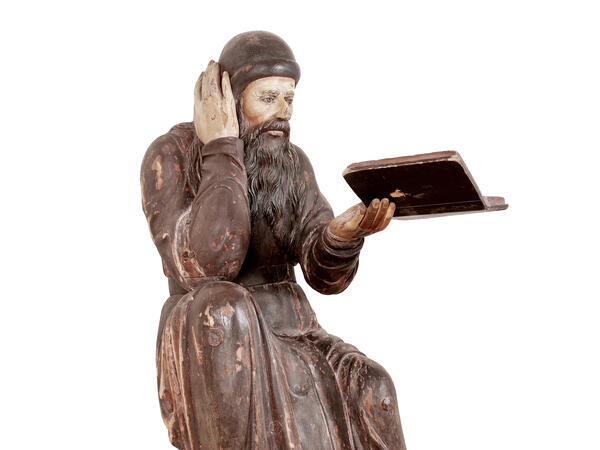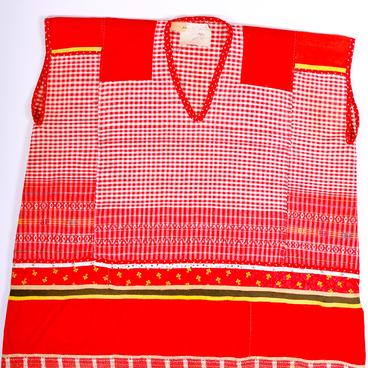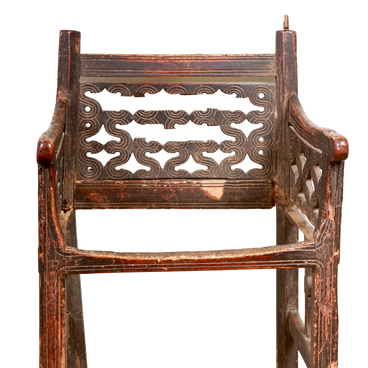The collection of the Kasimov Museum-Reserve contains a church wooden sculpture made in the 18th century. It is an unofficial symbol of the exhibition: in 2019, according to the results of the voting, visitors named the figure the most popular exhibit in the museum.
The sculpture has two names: ‘Monk the Chronicler’ or ‘The Sexton’. It is the figure of an elderly man sitting, holding a book in one hand, and clutching his head with the other.
It is not known exactly, who was the author of the wooden sculpture and why it was made, but there are several assumptions. Some researchers believed that ‘Monk the Chronicler’ was created by craftsmen who lived in the village of Gus-Zhelezny at the iron foundry of industrialists Batashev brothers.
There was a version that the object was ordered from Andrey Batashev by his patron, Prince Grigory Potemkin-Tavrichesky. It was also assumed, that Batashev himself presented him with a gift for a home chapel.
‘Monk the Chronicler’ entered the museum collection from the house of Barkov merchants. Initially, they were serfs on the Batashev estate. In 1815, the family was freed, and they settled in Kasimov. Three years later, the head of the family Dmitry Barkov bought a small house with a farmstead on the embankment of the Oka River.
In the late 1830s, the Barkovs rebuilt the wooden building and turned it into a mansion that had 14 rooms, a balcony, and a mezzanine on a stone foundation. The central part of the facade was decorated with six columns, between which a wrought-iron lattice in the Empire style was placed.
The Barkovs also changed the interiors: they decorated the main hall with a material resembling marble, gathered a large collection of books, paintings, and other art objects for the house.
In the 19th century, the Barkovs’ house was one of the centers of the secular life of the city. They organized parties and festivities, which sometimes were attended by 200 guests. In 1842, the Barkovs received the title of honorary citizens of Kasimov.
The house on Naberezhnaya Street was considered an architectural monument of federal significance. In 2020, there was a fire in it, and most of the building did not survive, only the portico with columns remained.
The sculpture has two names: ‘Monk the Chronicler’ or ‘The Sexton’. It is the figure of an elderly man sitting, holding a book in one hand, and clutching his head with the other.
It is not known exactly, who was the author of the wooden sculpture and why it was made, but there are several assumptions. Some researchers believed that ‘Monk the Chronicler’ was created by craftsmen who lived in the village of Gus-Zhelezny at the iron foundry of industrialists Batashev brothers.
There was a version that the object was ordered from Andrey Batashev by his patron, Prince Grigory Potemkin-Tavrichesky. It was also assumed, that Batashev himself presented him with a gift for a home chapel.
‘Monk the Chronicler’ entered the museum collection from the house of Barkov merchants. Initially, they were serfs on the Batashev estate. In 1815, the family was freed, and they settled in Kasimov. Three years later, the head of the family Dmitry Barkov bought a small house with a farmstead on the embankment of the Oka River.
In the late 1830s, the Barkovs rebuilt the wooden building and turned it into a mansion that had 14 rooms, a balcony, and a mezzanine on a stone foundation. The central part of the facade was decorated with six columns, between which a wrought-iron lattice in the Empire style was placed.
The Barkovs also changed the interiors: they decorated the main hall with a material resembling marble, gathered a large collection of books, paintings, and other art objects for the house.
In the 19th century, the Barkovs’ house was one of the centers of the secular life of the city. They organized parties and festivities, which sometimes were attended by 200 guests. In 1842, the Barkovs received the title of honorary citizens of Kasimov.
The house on Naberezhnaya Street was considered an architectural monument of federal significance. In 2020, there was a fire in it, and most of the building did not survive, only the portico with columns remained.


